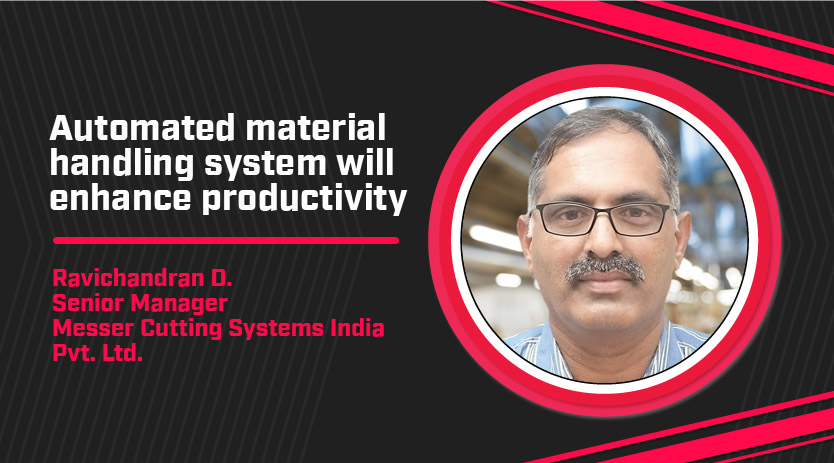Automated material handling system will enhance productivity
By OEM Update Editorial October 31, 2022 4:59 pm IST
Quality goods are in short supply and devoid of automation. They cannot be manufactured in the traditional way, which requires a lot of manual labour and manual monitoring.
The systems need to be more automated for higher productivity. It could be process automation for the machines. Automation can help the industry achieve higher productivity and more reliable production. Everything is interconnected, and the industry is looking at numerous cost-cutting measures. It lowers the cost of production and the cost of organising the entire system. So, implement process engineering systems, input cross-engineering systems, automated manufacturing and industrial automation to be productive.
Industrial automation and productivity
The automated manufacturing industry is suffering from a lack of industrial automation. It’s can be material handling systems feeding machines and digital automation monitoring the process. These two factors significantly improve productivity while also introducing an agile manufacturing system.It reduces manual labour inputs, which reduces product costs and increases productivity. Then production becomes more consistent, and with digital process automation, there is more transparency in the entire production system.
The process can be monitored in real-time and scheduled in advance. You can also get data and see if it’s happening or not.If there is any discrepancy or deviation from the actual plan, the process will give you information about what is happening immediately. As a Result, it will contribute to increased productivity.
A material handling system can increase production by 15 percent while reducing storage space by at least 40 percent and manual labour by 80 percent, resulting in lower handling costs. When a material handling system feeds a machine with a process automation system, be assured that the operating system or manufacturing zone becomes safer and more reliable. This improves material flow, reduces machine downtime, and thus indirectly increases productivity.
Messer Cutting Systems has a series of material handling systems primarily used for plate handling, sheet metal handling, and plate storage. Our industry is primarily concerned with Thermal Cutting. We have a basic system for Asia Pacific and a premium system for Europe and American countries, with CE & CSA norms. Regarding capacity, we can handle light material upto 12 mm, 25 mm, or 40 mm, and plates weighing up to five tonnes in a single pass.
In the thermal cutting industry, a storage and material handling system can be used to showcase a well organize machining environment. For example, you could have a forklift or crane load theinput material bundle and then store it vertically. Vertical storage can save up to 40 to 50 percent of floor space, and the entire system can be integrated with ERP, ensuring that the inventory is properly accounted for. The normal horizontal storage need shuffling of plates multiple times to a particular material type or size.
Whereas, for vertical storage, there exists a defined storage location and retrienal of plates is easy. After the plate has been cut into small parts, the unloader picks up the cut parts and drops them onto another a platform, conveyor or a mobile cart, in whatever configuration we choose. The cut plates are dropped all at once, while the fresh plate gets loaded into the machine. A variety of materials handling options are available. One storage system can feed multiple machines. If you have machines that don’t require storage, you can pick and load the machine, and the cut parts can be unloaded in a different location.
You can also have a shuttle to separate the cut parts from the machine area, making it a safer zone. The parts of the material handling system are highly configurable units. Everything is modular and can be configured in many ways based on machines, storage system and the process. These highly configurable parts can have an immediate impact on productivity.
Digital process automation
Many activities in a specific manufacturing industry are repetitive and manual. For example, if you want to know what’s being cut, the operator writes it down on paper and passes it on to the supervisor, who enters it into the ERP system. Typical questions in a shop floor are, “How do I know whether the machine is running low on material or has another problem? Is the machine under breakdown? Is it on the move? Or is it awaiting a maintenance problem?” When everything happens automatically, everyone has the information at their fingertips. It informs in real-time whether production is proceeding as planned or if there is a problem at any time, regardless of the nature of the problem. All of this can be automated, which is process automation. The benefits are real time feedback, high transparency, and effective process control. That is effective process control. All of this is only possible with the help of a digital process automation tool. Automation provides an extra tool that can help increase productivity. It implies digital technology automates the process and material workflow.
Each industry has its own workflow method. In a production-based sector, the steps that go through a manufacturing process are order management, work preparation (program preparation or tool preparation), production planning, scheduling, and machining operation.
Finally, for business analysis, it is to be seen that the schedule is adhered to. Suppose there is any deviation in plan or in the output component., the system needs to flash up details automatically for people to act upon.Messer Cutting Systems has all the tools data feedback from machines and workflow management when complex systems are used.
Cookie Consent
We use cookies to personalize your experience. By continuing to visit this website you agree to our Terms & Conditions, Privacy Policy and Cookie Policy.
















